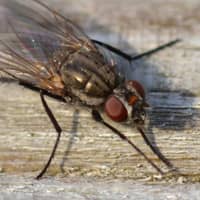
Cluster Flies

Cluster flies are found in homes and other structures. These large flies sometimes called "attic flies," appear on warm, sunny days during late autumn, winter, and early spring. They occur in large numbers, especially at windows and in rooms not frequently used. They make irritating, buzzing noises, spin around and move sluggishly. They do not bite humans nor feed on structures or furnishings, nor are they an indication of poor housekeeping or cleanliness.
Cluster Fly Identification
Adult cluster flies resemble house flies but are slightly larger, about 5/16 inch long, narrower and nonmetallic gray. When at rest, they overlap their wings at the tips, whereas the house fly does not.
Habits & Life Cycle Of Cluster Flies
Female cluster flies lay eggs singly in soil cracks and crevices in the vicinity of earthworms. Eggs hatch in three days and the larvae (parasitic stage) penetrate and develop in the bodies of earthworms. This larval stage lasts 13 to 22 days, and the pupae stage, 11 to 14 days. The complete life cycle ranges from 27 to 39 days so roughly 5 weeks after the egg has hatched, you have adult flies. There are about four generations during the summer.
Populations vary from year to year, sometimes worse after wet summers. Adult cluster flies will move to protected places to hibernate (this is also called overwintering) when the days shorten in mid-August. Flies cluster on the warm sides of buildings in late summer during the day. As the sun goes down and temperatures cool, flies crawl into the building through cracks, especially under eaves, gaps in siding, trim, and flashing. Large numbers may group together (cluster) in attics, unused rooms, wall voids, basements, tree holes, and other darkened sites. They are attracted to light, light-colored siding and structures on lawns and pastures inhabited by earthworms. They enter rooms through sash-cord openings, cracks in windowsills or baseboards, loose-fitting vinyl or aluminum siding, and other small openings. They become active whenever temperatures rise above 54°F indoors from early autumn to mid-spring, especially around windows with sunlight. A good rule of thumb is above 50°F, adult cluster flies are attracted to light. Below 50°F, the adults avoid light and seek tight-fitting, hidden places.
Cluster flies do not breed in buildings but leave hibernation sites in the spring (they often swarm onto windows on warm sunny days) to return outdoors for reproduction activity as noted above. Just as they become a nuisance in the fall while seeking hibernating quarters, they are also bothersome in the spring, trying to escape. We can go out and spot treat in the spring to give you some relief, but there is no guarantee and you may still see some flies. Treating later in the summer is usually more effective.
Treating Cluster Flies
Historically, infested buildings are best treated seasonally by an experienced professional exterminator. At American Pest Solutions, we do this using synthetic pyrethroids to control hibernating flies. Killing visible flies with space sprays and fogs does give temporary control… but unfortunately, additional flies are usually under insulation or deep in cracks and crevices. Also, flies will often continuously emerge from openings around window pulleys, window, and door casings, under baseboards, tops of wall studs, etc. If flies are bothersome when active during warm winter and early spring days they may be temporarily controlled by ordinary air spray, but the most effective treatment would be a very focused exterior spray to include soffits, peaks, eaves, and overhangs as well as window casing areas.
For best results cluster flies need to be treated from early August to late September depending on how far north you are in our Massachusetts and Connecticut service area. Once that window of opportunity has passed, it might be difficult to do an effective treatment. Although these flies are a real annoyance to homeowners, they don't pose a health hazard. Those that manage to blunder back outside serve as an important food source for many other animals. They're fat, and they're sluggish - the perfect prey. If only they'd go and live somewhere else!

Trust Massachusetts' oldest family owned pest control company to protect your family & home.